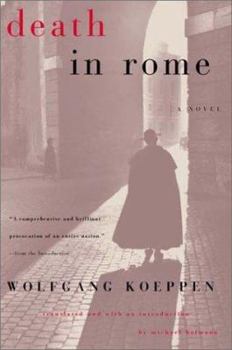Book Overview
Wolfgang Koeppen's Death in Rome, in the words of translator Michael Hofmann, is a comprehensive and brilliant provocation of an entire nation. First published in 1954 to great controversy, it is only now being recognized as a classic. A tragic portrait of Germany after World War II, Death in Rome completes the trilogy that earned Koeppen praise from G?nter Grass in his lifetime as the greatest living German writer. Mirroring the social and political upheaval following the fall of Nazism, Koeppen here offers the story of four members of a Germany family--a former SS officer, a young man preparing for the priesthood, a composer, and a government administrator--reunited by chance in the decaying beauty of postwar Rome. Koeppen re-creates the soul of a nation at a significant juncture of history in this devastating work of literary genius.
Format:Paperback
Language:English
ISBN:0393321940
ISBN13:9780393321944
Release Date:June 2001
Publisher:W. W. Norton & Company
Length:216 Pages
Weight:0.50 lbs.
Dimensions:0.6" x 5.0" x 8.0"
Customer Reviews
2 ratings
Excellent Insight into Post WWII-Germany
Published by Thriftbooks.com User , 19 years ago
This serves both as a guide to the beauty of Rome, with the Eternal City as the backdrop of this book, and a guide into the soul of post World War II Germany. An excellent plot, and interesting story, and incredible literary techniques make this a must-read for anyone with an interest in Rome, post-World War II Germany, or German authors in general. The sheer number of profound statements in this book is a testament to the genius of Wolfgang Koeppen. In addition, this is not a heavy read, thanks to a great translation, it is quite an easy read.
Brutal
Published by Thriftbooks.com User , 23 years ago
"Death In Rome", by Wolfgang Koeppen is characterized by Michael Hoffmann, who both translated the work, and wrote the introduction as, "the most devastating novel about the Germans I have ever read". This book was written in 1954 and when published caused a massive reaction, almost exclusively negative, for the primary characters were either participants in, or the offspring of the World War II Nazi regime. Published only 9 years after the defeat of The Third Reich, its subject matter was still white hot and equally sensitive. This was during a time when people were trying to put the past irrevocably behind them in the hope that time would provide distance, and distance would erode the world's memory.Everything in this book is at the very least provocative even when read from a distance of 50 years. The author even names his characters to overtly provoke, and incite. Gottlieb Judejahn and the other primary characters are family and obviously share the last name. Gottlieb's possession of the name is arguably the most notorious. He is generously characterized as an unreconstructed Nazi SS Officer whose last name combines the word for Jew with the balance that translates to madness, and weed out. Another name Pfaffrath is a disrespectful name for a priest, and the name Adolf needs no elaboration. The author evens ratchets up the tension when the son (the Priest Adolf) of the unrepentant SS Officer witnesses his father as he fouls a room deep in The Vatican. The author says that as he watched, "Adolf Wept".These examples are just parts of the setting that surround a bizarre family reunion in Rome. While unfortunate that Mr. Koeppen's work was so suppressed; it is not a stretch to understand why. With the wounds of the atrocities still fresh in the worlds' mind, and with some of the architects still roaming the streets of Europe, this author had the courage to not follow the crowd advocating let's put the past behind us, and to be brutally candid about what the end of the war meant and did not mean.





